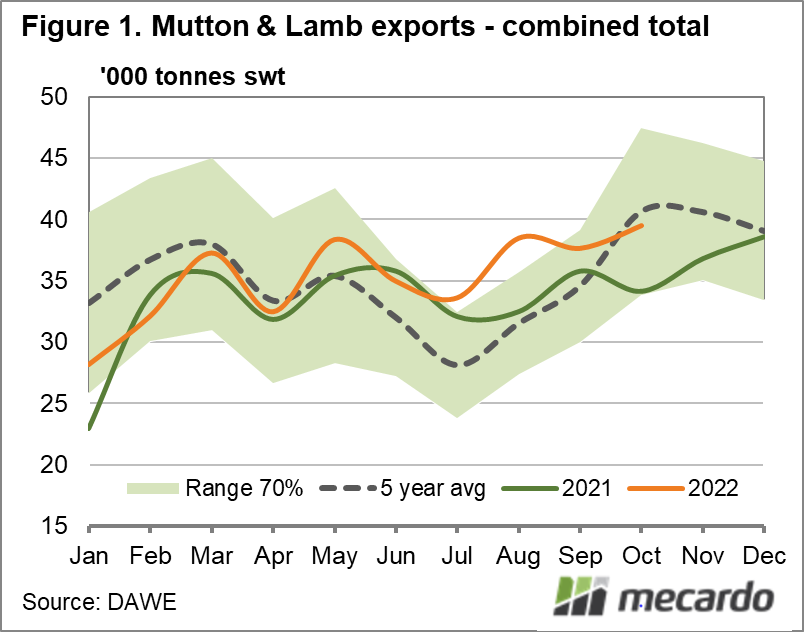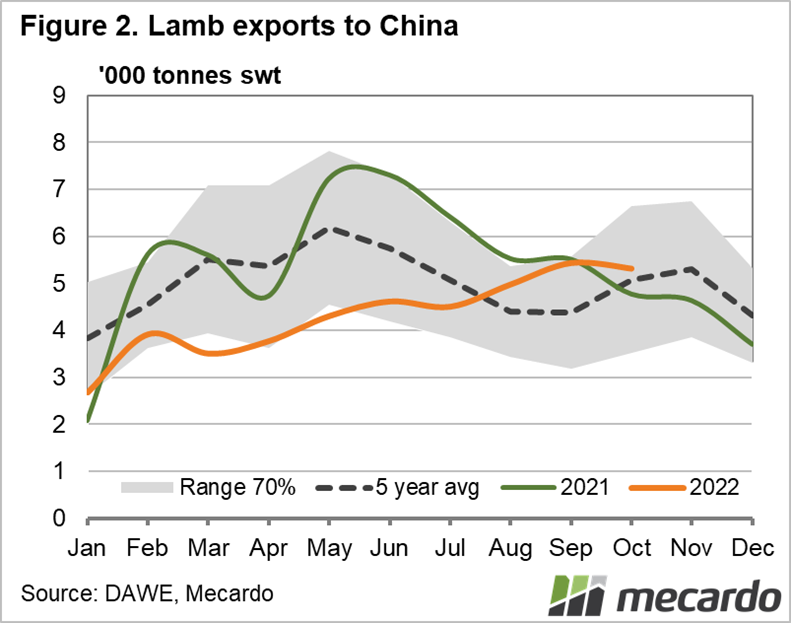Australian sheepmeat exports into China have failed to pick up much momentum this year, despite total lamb and mutton volumes sent offshore tracking above year-ago levels. Covid-19 lockdowns continue to impact the Chinese economy, which is on-top of a global economic slowdown. China is still Australia’s biggest mutton market, but it has dropped back to pre-2019 market share. Lamb exports, while seeing some positivity in the past two months, has spent most of the year below the 70% range.
Lamb exports to China gained some momentum in October, reaching the second highest volume on record for that month, with only 2019 surpassing it. It was the highest monthly volume sent to China this year, and the first time since January the monthly total surpassed the 2021 volume for the same month.
This said, it was still only marginally above the five-year-average, lamb exports for the year-to-October remained 22% below year-ago levels. The Chinese market is only taking 18% of Australia’s lamb export market share, compared to 21% at the same time last year, and down from 25% in 2019.
Mutton exports in October were also above year-ago levels, but for the first time since April fell below 2020 volumes. The mutton market has also fallen dramatically below the five-year average in September and October, having tracked in line or above it for the rest of the year. To put that into perspective, however, total mutton exports for those two months have also fallen below year-ago levels. Mutton exports to China are still marginally (2%) above 2021 for the year-to-date, but are also taking up 2% less of the market share (38%) than they were the same time last year.
Reports show despite lower sale prices and higher input prices, China’s pork production has been higher year-on-year each quarter for the past two years and was up nearly 6% for the first nine months of 2022 compared to the previous year. The US Department of Agriculture predicts pork production in China to increase a further 2% next year as the herd continues to recover from African swine fever, and its beef production to be up more than 5%. China is the world’s largest producer of sheepmeat, but is set to remain a net importer.
What does it mean?
China’s meat imports have been on the rise since 2014, and although the latest government policy focuses on self-sufficiency, even with the increased production of animal protein, the country’s demand continues to outweigh its supply. But seeing as it plays such a big role in Australia’s sheepmeat exports, its slowing economy and Covid-19 related uncertainty demand directly impact Australian exports and returns. Consumer sentiment, once they come out the other side of current lockdowns, will determine short-term demand, and the pace and extent of global economic downturn, will determine the more long-term one.
Have any questions or comments?
Key Points
- Lamb exports to China record second highest October volume on record, but market share is still at pre-2017 levels.
- Mutton exports to China for the month sit below the five-year average, but still makeup 38% of the Australian mutton export market.
- China’s imports of animal protein expected to dip further in 2023.
Click on figure to expand
Data sources: Mecardo; Meat & Livestock Australia; United States Department of Agriculture; Reuters




